Pop-In Phenomenon as a Fundamental Plasticity Probed by Nanoindentation Technique
Abstract
1. Introduction
2. Pioneering Works
3. Experimental Clarification
4. Physical Modeling
5. Effect of Pre-Existing Lattice Defects
5.1. Initial Dislocation Density
5.2. Solid Solution Element
5.3. Grain Boundary
6. Simulation
7. Other Mechanisms of the Event
8. Summary and Future Perspective
Author Contributions
Funding
Institutional Review Board Statement
Informed Consent Statement
Data Availability Statement
Conflicts of Interest
References
- Tabor, D. Hardness of Metals; Oxford Clarendon Press: Oxford, UK, 1951; p. 105. [Google Scholar]
- Nishibori, M.; Kinoshita, K. A Vickers type ultra-microhardness tester for thin films. Japan. J. Appl. Phys. 1997, 11, 758. [Google Scholar] [CrossRef]
- Nishibori, M.; Kinoshita, K. Ultra-microhardness of vacuum-deposited films I: Ultra-microhardness tester. Thin Solid Films 1978, 48, 325–331. [Google Scholar] [CrossRef]
- Newey, D.; Willkins, M.A.; Pollock, H.M. An ultra-low-load penetration hardness tester. J. Phys. E Sci. Instrum. 1982, 15, 119–122. [Google Scholar] [CrossRef]
- Loubet, J.L.; Georges, J.M.; Marchesini, O.; Meille, G. Vickers indentation curves of magnesium oxide (MgO). J. Tribol. 1984, 106, 43–48. [Google Scholar] [CrossRef]
- Doerner, M.F.; Nix, W.D. A method for interpreting the data from depth-sensing indentation instruments. J. Mater. Res. 1986, 1, 601–609. [Google Scholar] [CrossRef]
- Oliver, W.C.; Pharr, G.M. An improved technique for determining hardness and elastic modulus using load and displacement sensing indentation experiments. J. Mater. Res. 1992, 7, 1564–1583. [Google Scholar] [CrossRef]
- Tsui, T.Y.; Oliver, W.C.; Pharr, G.M. Influences of stress on the measurement of mechanical properties using nanoindentation: Part, I. Experimental studies in an aluminum alloy. J. Mater. Res. 1996, 11, 752–759. [Google Scholar] [CrossRef]
- Bolshakov, A.; Pharr, G.M. Influences of pileup on the measurement of mechanical properties by load and depth sensing indentation techniques. J. Mater. Res. 1998, 13, 1049–1058. [Google Scholar] [CrossRef]
- Lim, Y.Y.; Chaudhri, M. The effect of the indenter load on the nanohardness of ductile metals: An experimental study on polycrystalline work-hardened and annealed oxygen-free copper. Philos. Mag. A 1999, 79, 2979–3000. [Google Scholar] [CrossRef]
- Nix, W.D.; Gao, H. Indentation size effects in crystalline materials: A law for strain gradient plasticity. J. Mech. Phys. Solids 1998, 46, 411–425. [Google Scholar] [CrossRef]
- McElhaney, K.W.; Vlassak, J.J.; Nix, W.D. Determination of indenter tip geometry and indentation contact area for depth-sensing indentation experiments. J. Mater. Res. 1998, 13, 1300–1306. [Google Scholar] [CrossRef]
- Ohmura, T.; Tsuzaki, K. Mechanical characterization by nanoindentation technique. Mater. Jpn. 2007, 46, 251–258. [Google Scholar] [CrossRef]
- Gane, N.; Bowden, F.P. Microdeformation of Solids. J. Appl. Phys. 1968, 39, 1432–1435. [Google Scholar] [CrossRef]
- MacMillan, N.H.; Gane, N. Microdeformation of solids. J. Appl. Phys. 1970, 41, 672–673. [Google Scholar] [CrossRef]
- Gane, N.; Cox, J.M. The micro-hardness of metals at very low loads. Philos. Mag. 1970, 22, 881–891. [Google Scholar] [CrossRef]
- Landman, U.; Luedtke, W.D.; Burnham, N.A.; Colton, R.J. Atomistic mechanisms and dynamics of adhesion, nanoindentation, and fracture. Science 1990, 248, 454–461. [Google Scholar] [CrossRef] [PubMed]
- Sutton, A.P.; Pethica, J.B. Inelastic flow processes in nanometre volumes of solids. J. Phys. Conden. Matter 1990, 2, 5317–5326. [Google Scholar] [CrossRef]
- MacMillan, N.H. Review: The theoretical strength of solids. J. Mater. Sci. 1972, 7, 239–254. [Google Scholar] [CrossRef]
- Johnson, K.L. Contact Mechanics; Cambridge University Press: Cambridge, UK, 1985; pp. 84–106. [Google Scholar]
- Pethica, J.B.; Tabor, D. Contact of characterised metal surfaces at very low loads: Deformation and adhesion. Surf. Sci. 1979, 89, 182–190. [Google Scholar] [CrossRef]
- Venkataraman, S.K.; Gerberich, W.W.; Kohlstedt, D.L. Continuous microindentation of passivating surfaces. J. Mater. Res. 1993, 8, 685–688. [Google Scholar] [CrossRef]
- Gerberich, W.W.; Venkataraman, S.K.; Huang, H.; Harvey, S.E.; Kohlstedt, D.L. The injection of plasticity by millinewton contacts. Acta Metall. 1995, 43, 1569–1576. [Google Scholar] [CrossRef]
- Chechenin, N.G.; Bøttiger, J.; Krog, J.P. Nanoindentation of amorphous aluminum oxide films II. Critical parameters for the breakthrough and a membrane effect in thin hard films on soft substrates. Thin Solid Films 1995, 261, 228–235. [Google Scholar] [CrossRef]
- Gerberich, W.W.; Nelson, J.C.; Lilleodden, E.T.; Anderson, P.; Wyrobek, J.T. Indentation induced dislocation nucleation: The initial yield point. Acta Mater. 1996, 44, 3585–3598. [Google Scholar] [CrossRef]
- Bahr, D.F.; Nelson, J.C.; Tymiak, N.I.; Gerberich, W.W. The mechanical behavior of a passivating surface under potentiostatic control. J. Mater. Res. 1997, 12, 3345–3353. [Google Scholar] [CrossRef]
- Kramer, D.E.; Yoder, K.B.; Gerberich, W.W. Surface constrained plasticity Oxide rupture and the yield point process. Philos. Mag. A 2001, 81, 2033–2058. [Google Scholar] [CrossRef]
- Stauffer, D.D.; Major, R.C.; Vodnick, D.; Thomas, J.H.; Parker, J.; Manno, M.; Leighton, C.; Gerberich, W.W. Plastic response of the native oxide on Cr and Al thin films from in situ conductive nanoindentation. J. Mater. Res. 2012, 27, 685–693. [Google Scholar] [CrossRef]
- Mann, A.B.; Pethica, J.B. The effect of tip momentum on the contact stiffness and yielding during nanoindentation testing. Philos. Mag. A 1999, 79, 577–592. [Google Scholar] [CrossRef]
- Corcoran, S.; Colton, R.; Lilleodden, E.; Gerberich, W. Anomalous plastic deformation at surfaces: Nanoindentation of gold single crystals. Phys. Rev. B Condens. Matter Mater. Phys. 1997, 55, R16057–R16060. [Google Scholar] [CrossRef]
- Asif, S.A.S.; Pethica, J.B. Nanoindentation creep of single-crystal tungsten and gallium arsenide. Philos. Mag. 1997, 76, 1105–1118. [Google Scholar] [CrossRef]
- Barnoush, A. Correlation between dislocation density and nanomechanical response during nanoindentation. Acta Mater. 2012, 60, 1268–1277. [Google Scholar] [CrossRef]
- Suresh, S.; Nieh, T.-G.; Choi, B.W. Nano-indentation of copper thin films on silicon substrates. Scr. Mater. 1999, 41, 951–957. [Google Scholar] [CrossRef]
- Gouldstone, A.; Koh, H.J.; Zeng, K.Y.; Giannakopoulos, A.E.; Suresh, S. Discrete and continuous deformation during nanoindentation of thin films. Acta Mater. 2000, 48, 2277–2295. [Google Scholar] [CrossRef]
- Gerberich, W.W.; Mook, W.M.; Chambers, M.D.; Cordill, M.J.; Perrey, C.R.; Carter, C.B.; Miller, R.E.; Curtin, W.A.; Mukherjee, R.; Girshick, S.L. An energy balance criterion for nanoindentation-induced single and multiple dislocation events. J. Appl. Mech. Trans. ASME 2006, 73, 327–334. [Google Scholar] [CrossRef]
- Ohmura, T.; Zhang, L.; Sekido, K.; Tsuzaki, K. Effects of lattice defects on indentation-induced plasticity initiation behavior in metals. J. Mater. Res. 2012, 27, 1742–1749. [Google Scholar] [CrossRef]
- Anderson, P.M.; Hirth, J.P.; Lothe, J. Theory of Dislocations, 3rd ed.; Cambridge University Press: Cambridge, UK, 2017; p. 209. [Google Scholar]
- Remington, T.P.; Ruestes, C.J.; Bringa, E.M.; Remington, B.A.; Lu, C.H.; Kad, B.; Meyers, M.A. Plastic deformation in nanoindentation of tantalum: A new mechanism for prismatic loop formation. Acta Mater. 2014, 78, 378–393. [Google Scholar] [CrossRef]
- Zhang, L.; Ohmura, T. Plasticity Initiation and Evolution during Nanoindentation of an Iron–3% Silicon Crystal. Phys. Rev. Lett. 2014, 112, 145504. [Google Scholar] [CrossRef] [PubMed]
- Wu, Z.; Liu, W.; Zhang, L.; Lim, S. Amorphization and dislocation evolution mechanisms of single crystalline 6H-SiC. Acta Mater. 2020, 182, 60–67. [Google Scholar] [CrossRef]
- Suzuki, T.; Ohmura, T. Ultra-microindentation of silicon at elevated temperatures. Philos. Mag. A 1996, 74, 1073–1084. [Google Scholar] [CrossRef]
- Minor, A.M.; Syed Asif, S.A.; Shan, Z.; Stach, E.A.; Cyrankowski, E.; Wyrobek, T.J.; Warren, O.L. A new view of the onset of plasticity during the nanoindentation of aluminium. Nat. Mater. 2006, 5, 697–702. [Google Scholar] [CrossRef]
- Soer, W.A.; De Hosson, J.T.M.; Minor, A.M.; Shan, Z.; Asif, S.A.S.; Warren, O.L. Incipient plasticity in metallic thin films. Appl. Phys. Lett. 2007, 90, 1–4. [Google Scholar] [CrossRef]
- Navamathavan, R.; Park, S.J.; Hahn, J.H.; Choi, C.K. Nanoindentation “pop-in” phenomenon in epitaxial ZnO thin films on sapphire substrates. Mater. Charact. 2008, 59, 359–364. [Google Scholar] [CrossRef]
- Salehinia, I.; Lawrence, S.K.; Bahr, D.F. The effect of crystal orientation on the stochastic behavior of dislocation nucleation and multiplication during nanoindentation. Acta Mater. 2013, 61, 1421–1431. [Google Scholar] [CrossRef]
- Maughan, M.R.; Bahr, D.F. Dislocation activity under nanoscale contacts prior to discontinuous yield. Mater. Res. Lett. 2014, 3, 58–64. [Google Scholar] [CrossRef][Green Version]
- Lorenz, D.; Zeckzer, A.; Hilpert, U.; Grau, P.; Johansen, H.; Leipner, H.S. Pop-in effect as homogeneous nucleation of dislocations during nanoindentation. Phys. Rev. B Condens. Matter Mater. Phys. 2003, 67, 1–4. [Google Scholar] [CrossRef]
- Mao, W.G.; Shen, Y.G.; Lu, C. Deformation behavior and mechanical properties of polycrystalline and single crystal alumina during nanoindentation. Scr. Mater. 2011, 65, 127–130. [Google Scholar] [CrossRef]
- Schuh, C.A.; Mason, J.K.; Lund, A.C. Quantitative insight into dislocation nucleation from high-temperature nanoindentation experiments. Nat. Mater. 2005, 4, 617–621. [Google Scholar] [CrossRef]
- Bei, H.; Gao, Y.F.; Shim, S.; George, E.P.; Pharr, G.M. Strength differences arising from homogeneous versus heterogeneous dislocation nucleation. Phys. Rev. B Condens. Matter Mater. Phys. 2008, 77, 2–5. [Google Scholar] [CrossRef]
- Wu, D.; Nieh, T.G. Incipient plasticity and dislocation nucleation in body-centered cubic chromium. Mater. Sci. Eng. A 2014, 609, 110–115. [Google Scholar] [CrossRef]
- Xia, Y.Z.; Bei, H.; Gao, Y.F.; Catoor, D.; George, E.P. Synthesis, characterization, and nanoindentation response of single crystal Fe-Cr-Ni alloys with FCC and BCC structures. Mater. Sci. Eng. A 2014, 611, 177–187. [Google Scholar] [CrossRef]
- Vadalakonda, S.; Banerjee, R.; Puthcode, A.; Mirshams, R. Comparison of incipient plasticity in bcc and fcc metals studied using nanoindentation. Mater. Sci. Eng. A 2006, 426, 208–213. [Google Scholar] [CrossRef]
- Biener, M.M.; Biener, J.; Hodge, A.M.; Hamza, A.V. Dislocation nucleation in bcc Ta single crystals studied by nanoindentation. Phys. Rev. B Condens. Matter Mater. Phys. 2007, 76, 1–6. [Google Scholar] [CrossRef]
- Brinckmann, S.; Kim, J.Y.; Greer, J.R. Fundamental differences in mechanical behavior between two types of crystals at the nanoscale. Phys. Rev. Lett. 2008, 100, 1–4. [Google Scholar] [CrossRef] [PubMed]
- Greer, J.R.; Weinberger, C.R.; Cai, W. Comparing the strength of f.c.c. and b.c.c. sub-micrometer pillars: Compression experiments and dislocation dynamics simulations. Mater. Sci. Eng. A 2008, 493, 21–25. [Google Scholar] [CrossRef]
- Kiely, J.; Houston, J. Nanomechanical properties of Au (111), (001), and (110) surfaces. Phys. Rev. B Condens. Matter Mater. Phys. 1998, 57, 12588–12594. [Google Scholar] [CrossRef]
- Smith, R.; Christopher, D.; Kenny, S.D.; Richter, A.; Wolf, B. Defect generation and pileup of atoms during nanoindentation of Fe single crystals. Phys. Rev. B Condens. Matter Mater. Phys. 2003, 67, 1–10. [Google Scholar] [CrossRef]
- Murugaiah, A.; Barsoum, M.W.; Kalidindi, S.R.; Zhen, T. Spherical nanoindentations and kink bands in Ti3SiC2. J. Mater. Res. 2004, 19, 2194–2203. [Google Scholar] [CrossRef]
- Liang, H.; Woo, C.H.; Huang, H.; Ngan, A.H.W.; Yu, T.X. Crystalline plasticity on copper (001), (110), and (111) surfaces during nanoindentation. Comput. Model. Eng. Sci. 2004, 6, 105–114. [Google Scholar]
- Bhagavat, S.; Kao, I. Nanoindentation of lithium niobate: Hardness anisotropy and pop-in phenomenon. Mater. Sci. Eng. A 2005, 393, 327–331. [Google Scholar] [CrossRef]
- Tromas, C.; Gaillard, Y.; Woirgard, J. Nucleation of dislocations during nanoindentation in MgO. Philos. Mag. 2006, 86, 5595–5606. [Google Scholar] [CrossRef]
- Basu, S.; Barsoum, M.W.; Williams, A.D.; Moustakas, T.D. Spherical nanoindentation and deformation mechanisms in freestanding GaN films. J. Appl. Phys. 2007, 101, 1–7. [Google Scholar] [CrossRef]
- Alkorta, J.; Sevillano, J.G. Assessment of elastic anisotropy and incipient plasticity in Fe 3C by nanoindentation. J. Mater. Res. 2012, 27, 45–52. [Google Scholar] [CrossRef]
- Kwon, J.; Brandes, M.C.; Sudharshan Phani, P.; Pilchak, A.P.; Gao, Y.F.; George, E.P.; Pharr, G.M.; Mills, M.J. Characterization of deformation anisotropies in an α-Ti alloy by nanoindentation and electron microscopy. Acta Mater. 2013, 61, 4743–4756. [Google Scholar] [CrossRef]
- Catoor, D.; Gao, Y.F.; Geng, J.; Prasad, M.J.N.V.; Herbert, E.G.; Kumar, K.S.; Pharr, G.M.; George, E.P. Incipient plasticity and deformation mechanisms in single-crystal Mg during spherical nanoindentation. Acta Mater. 2013, 61, 2953–2965. [Google Scholar] [CrossRef]
- Pathak, S.; Riesterer, J.L.; Kalidindi, S.R.; Michler, J. Understanding pop-ins in spherical nanoindentation. Appl. Phys. Lett. 2014, 105, 1–5. [Google Scholar] [CrossRef]
- Weaver, J.S.; Priddy, M.W.; McDowell, D.L.; Kalidindi, S.R. On capturing the grain-scale elastic and plastic anisotropy of alpha-Ti with spherical nanoindentation and electron back-scattered diffraction. Acta Mater. 2016, 117, 23–34. [Google Scholar] [CrossRef]
- Nayyeri, G.; Poole, W.J.; Sinclair, C.W.; Zaefferer, S.; Konijnenberg, P.J.; Zambaldi, C. An instrumented spherical indentation study on high purity magnesium loaded nearly parallel to the c-axis. Mater. Sci. Eng. A 2016, 670, 132–145. [Google Scholar] [CrossRef]
- Zhang, W.; Gao, Y.; Xia, Y.; Bei, H. Indentation Schmid factor and incipient plasticity by nanoindentation pop-in tests in hexagonal close-packed single crystals. Acta Mater. 2017, 134, 53–65. [Google Scholar] [CrossRef]
- Somekawa, H.; Tsuru, T.; Singh, A.; Miura, S.; Schuh, C.A. Effect of crystal orientation on incipient plasticity during nanoindentation of magnesium. Acta Mater. 2017, 139, 21–29. [Google Scholar] [CrossRef]
- Michalske, T.A.; Houston, J.E. Dislocation nucleation at nano-scale mechanical contacts. Acta Mater. 1998, 46, 391–396. [Google Scholar] [CrossRef]
- Bushby, A.J.; Dunstan, D.J. Plasticity size effects in nanoindentation. J. Mater. Res. 2004, 19, 137–142. [Google Scholar] [CrossRef]
- Durst, K.; Göken, M.; Pharr, G.M. Indentation size effect in spherical and pyramidal indentations. J. Phys. D Appl. Phys. 2008, 41, 1–5. [Google Scholar] [CrossRef]
- Zhu, T.T.; Hou, X.D.; Bushby, A.J.; Dunstan, D.J. Indentation size effect at the initiation of plasticity for ceramics and metals. J. Phys. D Appl. Phys. 2008, 41, 074004. [Google Scholar] [CrossRef]
- Morris, J.R.; Bei, H.; Pharr, G.M.; George, E.P. Size effects and stochastic behavior of nanoindentation pop in. Phys. Rev. Lett. 2011, 106, 1–4. [Google Scholar] [CrossRef] [PubMed]
- Salehinia, I.; Perez, V.; Bahr, D.F. Effect of vacancies on incipient plasticity during contact loading. Philos. Mag. 2012, 92, 550–570. [Google Scholar] [CrossRef]
- Nowak, R.; Sekino, T.; Niihara, K. Non-linear surface deformation of the (1010) plane of sapphire: Identification of the linear features around spherical impressions. Acta Mater. 1999, 47, 4329–4338. [Google Scholar] [CrossRef]
- Kang, S.; Jung, Y.S.; Yoo, B.G.; Jang, J.I.; Lee, Y.K. Orientation-dependent indentation modulus and yielding in a high Mn twinning-induced plasticity steel. Mater. Sci. Eng. A 2012, 532, 500–504. [Google Scholar] [CrossRef]
- Alcalá, J.; Dalmau, R.; Franke, O.; Biener, M.; Biener, J.; Hodge, A. Planar defect nucleation and annihilation mechanisms in nanocontact plasticity of metal surfaces. Phys. Rev. Lett. 2012, 109, 17–21. [Google Scholar] [CrossRef]
- Guo, T.; Chao, Q.; Siska, F.; Cheng, J.; Varma, R.R.; Barnett, M.R. Analysing single twinning events in Mg-6Zn using nanoindentation. J. Alloys Compd. 2018, 768, 510–516. [Google Scholar] [CrossRef]
- Kuhr, B.R.; Aifantis, K.E. The Formation and Evolution of Defects in Nanocrystalline Fe during Indentation: The Role of Twins in Pop-Ins. Phys. Status Solidi Basic Res. 2019, 256, 1–6. [Google Scholar] [CrossRef]
- Twigg, P.C.; Riley, F.L.; Roberts, S.G. Nanoindentation investigation of micro-fracture wear mechanisms in polycrystalline alumina. J. Mater. Sci. 2002, 37, 845–853. [Google Scholar] [CrossRef]
- Ma, L.W.; Cairney, J.M.; McGrouther, D.; Hoffman, M.; Munroe, P.R. Three dimensional imaging of deformation modes in TiN-based thin film coatings. Thin Solid Films 2007, 515, 3190–3195. [Google Scholar] [CrossRef]
- Kataria, S.; Goyal, S.; Dash, S.; Sandhya, R.; Mathew, M.D.; Tyagi, A.K. Evaluation of nano-mechanical properties of hard coatings on a soft substrate. Thin Solid Films 2012, 522, 297–303. [Google Scholar] [CrossRef]
- Oliver, D.J.; Lawn, B.R.; Cook, R.F.; Reitsma, M.G.; Bradby, J.E.; Williams, J.S.; Munroe, P. Giant pop-ins in nanoindented silicon and germanium caused by lateral cracking. J. Mater. Res. 2008, 23, 297–301. [Google Scholar] [CrossRef]
- Lin, Y.C.; Weng, Y.J.; Pen, D.J.; Li, H.C. Deformation model of brittle and ductile materials under nano-indentation. Mater. Des. 2009, 30, 1643–1649. [Google Scholar] [CrossRef]
- Irwan, R.; Huang, H. Mechanical properties and fracture characteristics of cemented tungsten carbide with fine microstructure studied by nanoindentation. Int. J. Surface Sci. Eng. 2008, 2, 29–40. [Google Scholar] [CrossRef]
- Wang, J.L.; Ma, D.J.; Sun, L. The influence of crack forms on indentation hardness test results for ceramic materials. J. Mater. Sci. 2015, 50, 6096–6102. [Google Scholar] [CrossRef]
- Bahr, D.F.; Wilson, D.E.; Crowson, D.A. Energy considerations regarding yield points during indentation. J. Mater. Res. 1999, 14, 2269–2275. [Google Scholar] [CrossRef]
- Kucheyev, S.O.; Bradby, J.E.; Williams, J.S.; Jagadish, C.; Swain, M.V. Mechanical deformation of single-crystal ZnO. Appl. Phys. Lett. 2002, 80, 956–958. [Google Scholar] [CrossRef]
- Schuh, C.A.; Nieh, T.G.; Kawamura, Y. Rate dependence of serrated flow during nanoindentation of a bulk metallic glass. J. Mater. Res. 2002, 17, 1651–1654. [Google Scholar] [CrossRef]
- Chiu, Y.L.; Ngan, A.H.W. Time-dependent characteristics of incipient plasticity in nanoindentation of a Ni3Al single crystal. Acta Mater. 2002, 50, 1599–1611. [Google Scholar] [CrossRef]
- Schuh, C.A.; Lund, A.C. Application of nucleation theory to the rate dependence of incipient plasticity during nanoindentation. J. Mater. Res. 2004, 19, 2152–2158. [Google Scholar] [CrossRef]
- Lund, A.C.; Hodge, A.M.; Schuh, C.A. Incipient plasticity during nanoindentation at elevated temperatures. Appl. Phys. Lett. 2004, 85, 1362–1364. [Google Scholar] [CrossRef]
- Zhang, G.P.; Wang, W.; Zhang, B.; Tan, J.; Liu, C.S. On rate-dependent serrated flow behavior in amorphous metals during nanoindentation. Scr. Mater. 2005, 52, 1147–1151. [Google Scholar] [CrossRef]
- Wo, P.C.; Zuo, L.; Ngan, A.H.W. Time-dependent incipient plasticity in Ni3Al as observed in nanoindentation. J. Mater. Res. 2005, 20, 489–495. [Google Scholar] [CrossRef]
- Mason, J.K.; Lund, A.C.; Schuh, C.A. Determining the activation energy and volume for the onset of plasticity during nanoindentation. Phys. Rev. B Condens. Matter Mater. Phys. 2006, 73, 1–14. [Google Scholar] [CrossRef]
- Yang, P.F.; Lai, Y.S.; Jian, S.R.; Chen, J.; Chen, R.S. Nanoindentation identifications of mechanical properties of Cu6Sn5, Cu3Sn, and Ni3Sn4 intermetallic compounds derived by diffusion couples. Mater. Sci. Eng. A 2008, 485, 305–310. [Google Scholar] [CrossRef]
- Cordill, M.J.; Moody, N.R.; Gerberich, W.W. The role of dislocation walls for nanoindentation to shallow depths. Int. J. Plast. 2009, 25, 281–301. [Google Scholar] [CrossRef]
- Packard, C.E.; Franke, O.; Homer, E.R.; Schuh, C.A. Nanoscale strength distribution in amorphous versus crystalline metals. J. Mater. Res. 2010, 25, 2251–2263. [Google Scholar] [CrossRef]
- Rajulapati, K.V.; Biener, M.M.; Biener, J.; Hodge, A.M. Temperature dependence of the plastic flow behavior of tantalum. Philos. Mag. Lett. 2010, 90, 35–42. [Google Scholar] [CrossRef]
- Somekawa, H.; Schuh, C.A. Effect of solid solution elements on nanoindentation hardness, rate dependence, and incipient plasticity in fine grained magnesium alloys. Acta Mater. 2011, 59, 7554–7563. [Google Scholar] [CrossRef]
- Li, T.L.; Gao, Y.F.; Bei, H.; George, E.P. Indentation Schmid factor and orientation dependence of nanoindentation pop-in behavior of NiAl single crystals. J. Mech. Phys. Solids. 2011, 59, 1147–1162. [Google Scholar] [CrossRef]
- Li, T.L.; Bei, H.; Morris, J.R.; George, E.P.; Gao, Y.F. Scale effects in convoluted thermal/spatial statistics of plasticity initiation in small stressed volumes during nanoindentation. Mater. Sci. Technol. 2012, 28, 1055–1059. [Google Scholar] [CrossRef]
- Lu, J.Y.; Ren, H.; Deng, D.M.; Wang, Y.; Chen, K.J.; Lau, K.M.; Zhang, T.Y. Thermally activated pop-in and indentation size effects in GaN films. J. Phys. D Appl. Phys. 2012, 45, 1–7. [Google Scholar] [CrossRef]
- Paul, W.; Oliver, D.; Miyahara, Y.; Grütter, P.H. Minimum threshold for incipient plasticity in the atomic-scale nanoindentation of Au(111). Phys. Rev. Lett. 2013, 110, 1–5. [Google Scholar] [CrossRef] [PubMed]
- Kumar, V.; Gupta, A.; Lahiri, D.; Balani, K. Serrated yielding during nanoindentation of thermomechanically processed novel Mg-9Li-7Al-1Sn and Mg-9Li-5Al-3Sn-1Zn alloys. J. Phys. D Appl. Phys. 2013, 46, 1–8. [Google Scholar] [CrossRef]
- Franke, O.; Alcalá, J.; Dalmau, R.; Duan, Z.C.; Biener, J.; Biener, M.M.; Hodge, A.M. Incipient plasticity of single-crystal tantalum as a function of temperature and orientation. Philos. Mag. 2015, 95, 1866–1877. [Google Scholar] [CrossRef]
- Mridha, S.; Sadeghilaridjani, M.; Mukherjee, S. Activation volume and energy for dislocation nucleation in multi-principal element alloys. Metals 2019, 9, 27–33. [Google Scholar] [CrossRef]
- Sudharshan, P.P.; Oliver, W.C. Critical examination of experimental data on strain bursts (pop-in) during spherical indentation. J. Mater. Res. 2020, 35, 1028–1036. [Google Scholar] [CrossRef]
- Bahr, D.F.; Kramer, D.E.; Gerberich, W.W. Non-linear deformation mechanisms during nanoindentation. Acta Mater. 1998, 46, 3605–3617. [Google Scholar] [CrossRef]
- Miller, D.C.; Talmage, M.J.; Gall, K. Incipient yielding behavior during indentation for gold thin films before and after annealing. J. Mater. Res. 2006, 21, 2480–2492. [Google Scholar] [CrossRef]
- Zbib, A.A.; Bahr, D.F. Dislocation nucleation and source activation during nanoindentation yield points. Metall. Mater. Trans. A Phys. Metall. Mater. Sci. 2007, 38, 2249–2255. [Google Scholar] [CrossRef]
- Shim, S.; Bei, H.; George, E.P.; Pharr, G.M. A different type of indentation size effect. Scr. Mater. 2008, 59, 1095–1098. [Google Scholar] [CrossRef]
- Pathak, S.; Stojakovic, D.; Doherty, R.; Kalidindi, S.R. Importance of surface preparation on the nano-indentation stress-strain curves measured in metals. J. Mater. Res. 2009, 24, 1142–1155. [Google Scholar] [CrossRef]
- Lodes, M.A.; Hartmaier, A.; Göken, M.; Durst, K. Influence of dislocation density on the pop-in behavior and indentation size effect in CaF2 single crystals: Experiments and molecular dynamics simulations. Acta Mater. 2011, 59, 4264–4273. [Google Scholar] [CrossRef]
- Zhang, L.; Ohmura, T.; Seikido, K.; Nakajima, K.; Hara, T.; Tsuzaki, K. Direct observation of plastic deformation in iron-3% silicon single crystal by in situ nanoindentation in transmission electron microscopy. Scr. Mater. 2011, 64, 919–922. [Google Scholar] [CrossRef]
- Ahn, T.H.; Oh, C.S.; Lee, K.; George, E.P.; Han, H.N. Relationship between yield point phenomena and the nanoindentation pop-in behavior of steel. J. Mater. Res. 2012, 27, 39–44. [Google Scholar] [CrossRef]
- Sekido, K.; Ohmura, T.; Hara, T.; Tsuzaki, K. Effect of Dislocation Density on the Initiation of Plastic Deformation on Fe-C Steels. Mater. Trans. 2012, 53, 907–912. [Google Scholar] [CrossRef]
- Montagne, A.; Audurier, V.; Tromas, C. Influence of pre-existing dislocations on the pop-in phenomenon during nanoindentation in MgO. Acta Mater. 2013, 61, 4778–4786. [Google Scholar] [CrossRef]
- Maughan, M.R.; Bahr, D.F. Discontinuous yield behaviors under various pre-strain conditions in metals with different crystal structures. Mater. Res. Lett. 2015, 4, 83–89. [Google Scholar] [CrossRef]
- Bagheripoor, M.; Klassen, R. The effect of crystal anisotropy and pre-existing defects on the incipient plasticity of FCC single crystals during nanoindentation. Mech. Mater. 2020, 143, 1–13. [Google Scholar] [CrossRef]
- Patel, H.D.; Lee, S.W. Spherical nanoindentation on tungsten single crystal: The transition from source-controlled plasticity to bulk plasticity. Scr. Mater. 2020, 175, 16–19. [Google Scholar] [CrossRef]
- Mine, Y.; Doi, K.; Matsuoka, S.; Murakami, Y. The influences of hydrogen on microscopic plastic deformation behavior of SUS304 and SUS316L stainless steels. J. Soc. Mater. Sci. Jpn. 2008, 57, 255–261. [Google Scholar] [CrossRef][Green Version]
- Barnoush, A.; Asgari, M.; Johnsen, R. Resolving the hydrogen effect on dislocation nucleation and mobility by electrochemical nanoindentation. Scr. Mater. 2012, 66, 414–417. [Google Scholar] [CrossRef]
- Zamanzade, M.; Vehoff, H.; Barnoush, A. Cr effect on hydrogen embrittlement of Fe3Al-based iron aluminide intermetallics: Surface or bulk effect. Acta Mater. 2014, 69, 210–223. [Google Scholar] [CrossRef]
- Tian, L.; Tönnies, D.; Hirsbrunner, M.; Sievert, T.; Shan, Z.; Volkert, C.A. Effect of hydrogen charging on pop-in behavior of a Zr-based metallic glass. Metals 2020, 10, 13–15. [Google Scholar] [CrossRef]
- Bahr, D.F.; Vasquez, G. Effect of solid solution impurities on dislocation nucleation during nanoindentation. J. Mater. Res. 2005, 20, 1947–1951. [Google Scholar] [CrossRef]
- Le Bourhis, E.; Patriarche, G. Structure of nanoindentations in heavily n- and p-doped (0 0 1) GaAs. Acta Mater. 2008, 56, 1417–1426. [Google Scholar] [CrossRef]
- Krauss, G. STEELS, 2nd ed.; ASM International: Materials Park, OH, USA, 1990; p. 214. [Google Scholar]
- Nakano, K.; Ohmura, T. Effect of Solute Carbon on Onset of Local Plastic Deformation in BCC Iron. J. Iron Steel Inst. Jpn. 2020, 106, 372–381. [Google Scholar] [CrossRef]
- Chen, J.; Wang, W.; Qian, L.H.; Lu, K. Critical shear stress for onset of plasticity in a nanocrystalline Cu determined by using nanoindentation. Scr. Mater. 2003, 49, 645–650. [Google Scholar] [CrossRef]
- Wang, M.G.; Ngan, A.H.W. Indentation strain burst phenomenon induced by grain boundaries in niobium. J. Mater. Res. 2004, 19, 2478–2486. [Google Scholar] [CrossRef]
- Ohmura, T.; Tsuzaki, K.; Yin, F. Nanoindentation-induced deformation behavior in the vicinity of single grain boundary of interstitial-free steel. Mater. Trans. 2005, 46, 2026–2029. [Google Scholar] [CrossRef]
- Yang, B.; Vehoff, H. Grain size effects on the mechanical properties of nanonickel examined by nanoindentation. Mater. Sci. Eng. A 2005, 400, 467–470. [Google Scholar] [CrossRef]
- Ohmura, T.; Tsuzaki, K. Plasticity initiation and subsequent deformation behavior in the vicinity of single grain boundary investigated through nanoindentation technique. J. Mater. Sci. 2007, 42, 1728–1732. [Google Scholar] [CrossRef]
- Britton, T.B.; Randman, D.; Wilkinson, A.J. Nanoindentation study of slip transfer phenomenon at grain boundaries. J. Mater. Res. 2009, 24, 607–615. [Google Scholar] [CrossRef]
- Khosravani, A.; Morsdorf, L.; Tasan, C.C.; Kalidindi, S.R. Multiresolution mechanical characterization of hierarchical materials: Spherical nanoindentation on martensitic Fe-Ni-C steels. Acta Mater. 2018, 153, 257–269. [Google Scholar] [CrossRef]
- Shen, Z.; Wang, B.; Liang, G.; Zhang, Y.; Han, K.; Song, C. Grain boundary pop-in, yield point phenomenon and carbon segregation in aged low carbon steel. ISIJ Int. 2018, 58, 373–375. [Google Scholar] [CrossRef]
- Javaid, F.; Durst, K. Stress-driven grain boundary movement during nanoindentation in tungsten at room temperature. Materialia 2018, 1, 99–103. [Google Scholar] [CrossRef]
- Pöhl, F. Pop-in behavior and elastic-to-plastic transition of polycrystalline pure iron during sharp nanoindentation. Sci. Rep. 2019, 9, 1–13. [Google Scholar] [CrossRef] [PubMed]
- Javaid, F.; Xu, Y.; Durst, K. Local analysis on dislocation structure and hardening during grain boundary pop-ins in tungsten. J. Mater. Sci. 2020, 55, 9597–9607. [Google Scholar]
- Hall, E.O. The Deformation and Ageing of Mild Steel: III Discussion of Results. Proc. R. Soc. B 1951, 64, 747–753. [Google Scholar] [CrossRef]
- Petch, N.J. The Cleavage Strength of Polycrystals. J. Iron Steel Inst. 1953, 174, 25–28. [Google Scholar]
- Gouldstone, A.; van Vliet, K.J.; Suresh, S. Nanoindentation: Simulation of defect nucleation in a crystal. Nature 2001, 411, 656. [Google Scholar] [CrossRef] [PubMed]
- Marian, J.; Cai, W.; Bulatov, V.V. Dynamic transitions from smooth to rough to twinning in dislocation motion. Nat. Mater. 2004, 3, 158–163. [Google Scholar] [CrossRef] [PubMed]
- Xu, G.; Argon, A.S. Energetics of homogeneous nucleation of dislocation loops under a simple shear stress in perfect crystals. Mater. Sci. Eng. A 2001, 319-321, 144–147. [Google Scholar] [CrossRef]
- Nemat-Nasser, S.; Okinaka, T.; Ni, L. A physically-based constitutive model for BCC crystals with application to polycrystalline tantalum. J. Mech. Phys. Solids 1998, 46, 1009–1038. [Google Scholar] [CrossRef]
- Ruestes, C.J.; Stukowski, A.; Tang, Y.; Tramontina, D.R.; Erhart, P.; Remington, B.A.; Urbassek, H.M.; Meyers, M.A.; Bringa, E.M. Atomistic simulation of tantalum nanoindentation: Effects of indenter diameter, penetration velocity, and interatomic potentials on defect mechanisms and evolution. Mater. Sci. Eng. A 2014, 613, 390–403. [Google Scholar] [CrossRef]
- Needleman, A.; Ortiz, M. Effect of boundaries and interfaces on shear-band localization. Int. J. Solids Struct. 1991, 28, 859–877. [Google Scholar] [CrossRef]
- Bhushan, B.; Israelachvili, J.N.; Landman, U. Nanotribology: Friction, wear and lubrication at the atomic scale. Nature 1995, 374, 607–616. [Google Scholar] [CrossRef]
- Shenoy, V.B.; Phillips, R.; Tadmor, E.B. Nucleation of dislocations beneath a plane strain indenter. J. Mech. Phys. Solids 2000, 48, 649–673. [Google Scholar] [CrossRef]
- Xia, Y.; Gao, Y.; Pharr, G.M.; Bei, H. Single versus successive pop-in modes in nanoindentation tests of single crystals. J. Mater. Res. 2016, 31, 2065–2075. [Google Scholar] [CrossRef]
- Zhou, N.; Elkhodary, K.I.; Huang, X.; Tang, S.; Li, Y. Dislocation structure and dynamics govern pop-in modes of nanoindetation on single-crystal metals. Philos. Mag. 2020, 100, 1585–1606. [Google Scholar] [CrossRef]
- Du, J.P.; Wang, Y.J.; Lo, Y.C.; Wan, L.; Ogata, S. Mechanism transition and strong temperature dependence of dislocation nucleation from grain boundaries: An accelerated molecular dynamics study. Phys. Rev. B 2016, 94, 1–8. [Google Scholar] [CrossRef]
- Li, Y.; Goyal, A.; Chernatynskiy, A.; Jayashankar, J.S.; Kautzky, M.C.; Sinnott, S.B.; Phillpot, S.R. Nanoindentation of gold and gold alloys by molecular dynamics simulation. Mater. Sci. Eng. A 2016, 651, 346–357. [Google Scholar]
- Cheung, K.S.; Yip, S. Atomic-level stress in an inhomogeneous system. J. Appl. Phys. 1991, 70, 5688–5690. [Google Scholar] [CrossRef]
- Zuo, L.; Ngan, A.H.W.; Zheng, G.P. Size dependence of incipient dislocation plasticity in Ni3Al. Phys. Rev. Lett. 2005, 94, 1–4. [Google Scholar] [CrossRef]
- Chen, H.P.; Kalia, R.K.; Nakano, A.; Vashishta, P.; Szlufarska, I. Multimillion-atom nanoindentation simulation of crystalline silicon carbide: Orientation dependence and anisotropic pileup. J. Appl. Phys. 2007, 102, 1–9. [Google Scholar] [CrossRef]
- Cawkwell, M.J.; Ramos, K.J.; Hooks, D.E.; Sewell, T.D. Homogeneous dislocation nucleation in cyclotrimethylene trinitramine under shock loading. J. Appl. Phys. 2010, 107, 063512. [Google Scholar] [CrossRef]
- Begau, C.; Hartmaier, A.; George, E.P.; Pharr, G.M. Atomistic processes of dislocation generation and plastic deformation during nanoindentation. Acta Mater. 2011, 59, 934–942. [Google Scholar] [CrossRef]
- Komanduri, R.; Chandrasekaran, N.; Raff, L.M. MD simulation of indentation and scratching of single crystal aluminum. Wear 2000, 240, 113–143. [Google Scholar] [CrossRef]
- Lu, C.J.; Bogy, D.B. The effect of tip radius on nano-indentation hardness tests. Int. J. Solids Struct. 1995, 32, 1759–1770. [Google Scholar] [CrossRef]
- Engels, P.; Ma, A.; Hartmaier, A. Continuum simulation of the evolution of dislocation densities during nanoindentation. Int. J. Plast. 2012, 38, 159–169. [Google Scholar] [CrossRef]
- Tadmor, E.B.; Miller, R.; Phillips, R.; Ortiz, M. Nanoindentation and incipient plasticity. J. Mater. Res. 1999, 14, 2233–2250. [Google Scholar] [CrossRef]
- Li, W.; Siegmund, T. Numerical study of indentation delamination of strongly bonded films by use of a cohesive zone model. CMES Comput. Model. Eng. Sci. 2004, 5, 81–90. [Google Scholar]
- Wagner, R.J.; Ma, L.; Tavazza, F.; Levine, L.E. Dislocation nucleation during nanoindentation of aluminum. J. Appl. Phys. 2008, 104, 114311. [Google Scholar] [CrossRef]
- Ogata, S.; Li, J.; Yip, S. Ideal pure shear strength of aluminum and copper. Science 2002, 298, 807–811. [Google Scholar] [CrossRef]
- Ogata, S.; Li, J.; Hirosaki, N.; Shibutani, Y.; Yip, S. Ideal shear strain of metals and ceramics. Phys. Rev. B Condens. Matter Mater. Phys. 2004, 70, 1–7. [Google Scholar] [CrossRef]
- Nagasako, N.; Jahnátek, M.; Asahi, R.; Hafner, J. Anomalies in the response of V, Nb, and Ta to tensile and shear loading: Ab initio density functional theory calculations. Phys. Rev. B Condens. Matter Mater. Phys. 2010, 81, 1–13. [Google Scholar] [CrossRef]
- Liang, H.Y.; Woo, C.H.; Huang, H.; Ngan, A.H.W.; Yu, T.X. Dislocation nucleation in the initial stage during nanoindentation. Philos. Mag. 2003, 83, 3609–3622. [Google Scholar] [CrossRef]
- Hoover, W.G.; de Groot, A.J.; Hoover, C.G.; Stowers, I.F.; Kawai, T.; Holian, B.L.; Boku, T.; Ihara, S.; Belak, J. Large-scale elastic-plastic indentation simulations via nonequilibrium molecular dynamics. Phys. Rev. A 1990, 42, 5844–5853. [Google Scholar] [CrossRef] [PubMed]
- Haussy, B.; Ganghoffer, J.F. Atomistic mechanisms of adhesive contact formation and interfacial processes. Arch. Appl. Mech. 2006, 75, 338–354. [Google Scholar] [CrossRef]
- Kelchner, C.L.; Plimpton, S.J.; Hamilton, J.C. Dislocation nucleation and defect structure during surface indentation. Phys. Rev. B Condens. Matter Mater. Phys. 1998, 58, 11085–11088. [Google Scholar] [CrossRef]
- Li, J.; Van Vliet, K.J.; Zhu, T.; Yip, S.; Suresh, S. Atomistic mechanisms governing elastic limit and incipient plasticity in crystals. Nature 2002, 418, 307–310. [Google Scholar] [CrossRef]
- Zhu, T.; Li, J.; van Vliet, K.J.; Ogata, S.; Yip, S.; Suresh, S. Predictive modeling of nanoindentation-induced homogeneous dislocation nucleation in copper. J. Mech. Phys. Solids 2004, 52, 691–724. [Google Scholar] [CrossRef]
- Sato, Y.; Shinzato, S.; Ohmura, T.; Ogata, S. Atomistic prediction of the temperature- and loading-rate-dependent first pop-in load in nanoindentation. Int. J. Plast. 2019, 121, 280–292. [Google Scholar] [CrossRef]
- Fan, Y.; Osetsky, Y.N.; Yip, S.; Yildiz, B. Onset mechanism of strain-rate-induced flow stress upturn. Phys. Rev. Lett. 2012, 109, 1–5. [Google Scholar] [CrossRef]
- Salehinia, I.; Medyanik, S.N. Effects of vacancies on the onset of plasticity in metals-an atomistic simulation study. Metall. Mater. Trans. A: Phys. Metall. Mater. Sci. 2011, 42, 3868–3874. [Google Scholar] [CrossRef]
- Zimmerman, J.A.; Kelchner, C.L.; Klein, P.A.; Hamilton, J.C.; Foiles, S.M. Surface step effects on nanoindentation. Phys. Rev. Lett. 2001, 87, 14–17. [Google Scholar] [CrossRef]
- Yang, B.; Zheng, B.; Hu, X.; Zhang, K.; Li, Y.; He, P.; Yue, Z. Atomistic simulation of nanoindentation on incipient plasticity and dislocation evolution in γ/γ′ phase with interface and void. Comput. Mater. Sci. 2016, 114, 172–177. [Google Scholar] [CrossRef]
- Lu, S.; Zhang, B.; Li, X.; Zhao, J.; Zaiser, M.; Fan, H.; Zhang, X. Grain boundary effect on nanoindentation: A multiscale discrete dislocation dynamics model. J. Mech. Phys. Solids 2019, 126, 117–135. [Google Scholar] [CrossRef]
- Song, H.; Yavas, H.; van der Giessen, E.; Papanikolaou, S. Discrete dislocation dynamics simulations of nanoindentation with pre-stress: Hardness and statistics of abrupt plastic events. J. Mech. Phys. Solids 2019, 123, 332–347. [Google Scholar] [CrossRef]
- Fivel, M.C.; Robertson, C.F.; Canova, G.R.; Boulanger, L. Three-dimensional modeling of indent-induced plastic zone at a mesoscale. Acta Mater. 1998, 46, 6183–6194. [Google Scholar] [CrossRef]
- Rezaee-Hajidehi, M.; Stupkiewicz, S. Phase-field modeling of multivariant martensitic microstructures and size effects in nano-indentation. Mech. Mater. 2020, 141, 1–14. [Google Scholar] [CrossRef]
- Ma, L.; Morris, D.J.; Jennerjohn, S.L.; Bahr, D.F.; Levine, L. Finite element analysis and experimental investigation of the Hertzian assumption on the characterization of initial plastic yield. J. Mater. Res. 2009, 24, 1059–1068. [Google Scholar] [CrossRef]
- Krenn, C.R.; Roundy, D.; Cohen, M.L.; Chrzan, D.C.; Morris, J.W. Connecting atomistic and experimental estimates of ideal strength. Phys. Rev. B Condens. Matter Mater. Phys. 2002, 65, 1–4. [Google Scholar] [CrossRef]
- Horníková, J.; Šandera, P.; Černý, M.; Pokluda, J. Multiscale modelling of nanoindentation test in copper crystal. Eng. Fract. Mech. 2008, 75, 3755–3762. [Google Scholar] [CrossRef]
- Engels, P.S.; Begau, C.; Gupta, S.; Schmaling, B.; Ma, A.; Hartmaier, A. Multiscale modeling of nanoindentation: From Atomistic to continuum models. Solid Mech. Appl. 2014, 203, 285–322. [Google Scholar]
- Smith, G.S.; Tadmor, E.B.; Bernstein, N.; Kaxiras, E. Multiscale simulations of silicon nanoindentation. Acta Mater. 2001, 49, 4089–4101. [Google Scholar] [CrossRef]
- Spaepen, F. A microscopic mechanism for steady state inhomogeneous flow in metallic glasses. Acta Metall. 1977, 25, 407–415. [Google Scholar] [CrossRef]
- Argon, A.S. Plastic deformation in metallic glasses. Acta Metall. 1979, 27, 47–58. [Google Scholar] [CrossRef]
- Schuh, C.A.; Nieh, T.G. A nanoindentation study of serrated flow in bulk metallic glasses. Acta Mater. 2003, 51, 87–99. [Google Scholar] [CrossRef]
- Mukhopadhyay, N.K.; Belger, A.; Paufler, P.; Kim, D.H. Nanoindentation studies on Cu-Ti-Zr-Ni-Si-Sn bulk metallic glasses. Mater. Sci. Eng. A 2007, 449, 954–957. [Google Scholar] [CrossRef]
- Li, N.; Chan, K.C.; Liu, L. The indentation size effect in Pd40Cu30Ni 10P20 bulk metallic glass. J. Phys. D Appl. Phys. 2008, 41, 155415. [Google Scholar]
- Wang, L.; Song, S.X.; Nieh, T.G. Assessing plastic shear resistance of bulk metallic glasses under nanoindentation. Appl. Phys. Lett. 2008, 92, 2006–2009. [Google Scholar] [CrossRef]
- Chen, K.W.; Jian, S.R.; Wei, P.J.; Jang, J.S.C.; Lin, J.F. The study of loading rate effect of a Cu-based bulk metallic glass during nanoindentation. J. Alloys Compd. 2010, 504, 69–73. [Google Scholar] [CrossRef]
- Kim, J.T.; Hong, S.H.; Lee, C.H.; Park, J.M.; Kim, T.W.; Lee, W.H.; Yim, H.I.; Kim, K.B. Plastic deformation behavior of Fe-Co-B-Si-Nb-Cr bulk metallic glasses under nanoindentation. J. Alloys Compd. 2014, 587, 415–419. [Google Scholar] [CrossRef]
- Huang, Y.; Zhou, B.; Chiu, Y.; Fan, H.; Wang, D.; Sun, J.; Shen, J. The structural relaxation effect on the nanomechanical properties of a Ti-based bulk metallic glass. J. Alloys Compd. 2014, 608, 148–152. [Google Scholar] [CrossRef]
- Nekouie, V.; Abeygunawardane-Arachchige, G.; Kühn, U.; Roy, A.; Silberschmidt, V.V. Indentation-induced deformation localisation in Zr-Cu-based metallic glass. J. Alloys Compd. 2015, 615, S93–S97. [Google Scholar] [CrossRef][Green Version]
- Limbach, R.; Kosiba, K.; Pauly, S.; Kühn, U.; Wondraczek, L. Serrated flow of CuZr-based bulk metallic glasses probed by nanoindentation: Role of the activation barrier, size and distribution of shear transformation zones. J. Non-Cryst. Solids 2017, 459, 130–141. [Google Scholar] [CrossRef]
- Avila, K.E.; Küchemann, S.; Alhafez, I.A.; Urbassek, H.M. Shear-transformation zone activation during loading and unloading in nanoindentation of metallic glasses. Materials 2019, 12, 1–17. [Google Scholar] [CrossRef]
- Chu, Q.; Xu, S.; Zhu, X.; Zhu, Z.; Zhang, H.; Bai, R.; Lei, Z.; Yan, C. Effects of testing conditions on the deformation behaviour of a Ti-based bulk metallic glass. Mater. Sci. Eng. A 2019, 766, 138404. [Google Scholar] [CrossRef]
- Marimuthu, K.P.; Lee, K.; Han, J.; Rickhey, F.; Lee, H. Nanoindentation of zirconium based bulk metallic glass and its nanomechanical properties. J. Mater. Res. Technol. 2020, 9, 104–114. [Google Scholar] [CrossRef]
- Malekmotiei, L.; Samadi-Dooki, A.; Voyiadjis, G.Z. Nanoindentation study of yielding and plasticity of poly (methyl methacrylate). Macromolecules 2015, 48, 5348–5357. [Google Scholar] [CrossRef]
- Samadi-Dooki, A.; Malekmotiei, L.; Voyiadjis, G.Z. Characterizing shear transformation zones in polycarbonate using nanoindentation. Polymer 2016, 82, 238–245. [Google Scholar] [CrossRef]
- Malekmotiei, L.; Voyiadjis, G.Z.; Samadi-Dooki, A.; Lu, F.; Zhou, J. Effect of annealing temperature on interrelation between the microstructural evolution and plastic deformation in polymers. J. Polym. Sci. B Polym. Phys. 2017, 55, 1286–1297. [Google Scholar] [CrossRef]
- Bradby, J.E.; Williams, J.S.; Wong-Leung, J.; Swain, M.V.; Munroe, P. Mechanical deformation in silicon by micro-indentation. J. Mater. Res. 2001, 16, 1500–1507. [Google Scholar] [CrossRef]
- Bradby, J.E.; Williams, J.S.; Swain, M.V. In situ electrical characterization of phase transformations in Si during indentation. Phys. Rev. B Condens. Matter Mater. Phys. 2003, 67, 1–9. [Google Scholar] [CrossRef]
- Ivashchenko, V.I.; Turchi, P.E.A.; Shevchenko, V.I. Simulations of indentation-induced phase transformations in crystalline and amorphous silicon. Phys. Rev. B Condens. Matter Mater. Phys. 2008, 78, 1–12. [Google Scholar] [CrossRef]
- Chang, L.; Zhang, L.C. The plasticity of monocrystalline silicon under nanoindentation. Int. J. Modern Phys. B 2008, 22, 6022–6028. [Google Scholar] [CrossRef]
- Chang, L.; Zhang, L. Mechanical behaviour characterisation of silicon and effect of loading rate on pop-in: A nanoindentation study under ultra-low loads. Mater. Sci. Eng. A 2009, 506, 125–129. [Google Scholar] [CrossRef]
- Han, C.F.; Huang, C.Y.; Wu, B.H.; Lin, J.F. The nanoindentation applied to predict the interface delamination for the C/amorphous Si composite film. J. Appl. Phys. 2009, 106, 1–7. [Google Scholar] [CrossRef]
- Chang, L.; Zhang, L.C. The deformation mechanism at pop-in: Monocrystalline silicon under nanoindentation with a Berkovich indenter. Key Eng. Mater. 2009, 389–390, 453–458. [Google Scholar] [CrossRef]
- Oliver, D.J.; Bradby, J.E.; Williams, J.S.; Swain, M.V.; Munroe, P. Giant pop-ins and amorphization in germanium during indentation. J. Appl. Phys. 2007, 101, 1–9. [Google Scholar] [CrossRef]
- Bradby, J.E.; Williams, J.S.; Wong-Leung, J.; Kucheyev, S.O.; Swain, M.V.; Munroe, P. Spherical indentation of compound semiconductors. Philos. Mag. A 2002, 82, 1931–1939. [Google Scholar] [CrossRef]
- Caër, C.; Patoor, E.; Berbenni, S.; Lecomte, J.S. Stress induced pop-in and pop-out nanoindentation events in CuAlBe shape memory alloys. Mater. Sci. Eng. A 2013, 587, 304–312. [Google Scholar] [CrossRef]
- Ma, Y.; Mayr, S.G. Nanoindentation response of substrate-attached and freestanding single-crystalline Fe7Pd3 ferromagnetic shape memory thin films around the martensite transition: The impact of constraints and beyond. Acta Mater. 2013, 61, 6756–6764. [Google Scholar] [CrossRef]
- Laplanche, G.; Pfetzing-Micklich, J.; Eggeler, G. Sudden stress-induced transformation events during nanoindentation of NiTi shape memory alloys. Acta Mater. 2014, 78, 144–160. [Google Scholar] [CrossRef]
- Davis, P.H.; Efaw, C.M.; Patten, L.K.; Hollar, C.; Watson, C.S.; Knowlton, W.B.; Müllner, P. Localized deformation in Ni-Mn-Ga single crystals. J. Appl. Phys. 2018, 123, 1–7. [Google Scholar] [CrossRef]
- Lu, X.; Li, W.; Zhao, H.; Jin, X. Local plastic indentation resistance of retained austenite in bearing steel. ISIJ Int. 2016, 56, 851–854. [Google Scholar] [CrossRef]
- Zambrano, O.A.; Valdés, J.; Aguilar, Y.; Coronado, J.J.; Rodríguez, S.A.; Logé, R.E. Hot deformation of a Fe-Mn-Al-C steel susceptible of κ-carbide precipitation. Mater. Sci. Eng. A 2017, 689, 269–285. [Google Scholar] [CrossRef]
- Zinsaz-Borujerdi, A.; Zarei-Hanzaki, A.; Abedi, H.R.; Karam-Abian, M.; Ding, H.; Han, D.; Kheradmand, N. Room temperature mechanical properties and microstructure of a low alloyed TRIP-assisted steel subjected to one-step and two-step quenching and partitioning process. Mater. Sci. Eng. A 2018, 725, 341–349. [Google Scholar] [CrossRef]
- Roa, J.J.; Sapezanskaia, I.; Fargas, G.; Kouitat, R.; Redjaïmia, A.; Mateo, A. Dynamic Deformation of Metastable Austenitic Stainless Steels at the Nanometric Length Scale. Metall. Mater. Trans. A 2018, 49, 6034–6039. [Google Scholar] [CrossRef]
- Man, T.; Ohmura, T.; Tomota, Y. Mechanical behavior of individual retained austenite grains in high carbon quenched-tempered steel. ISIJ Int. 2019, 59, 559–566. [Google Scholar] [CrossRef]
- Man, T.; Ohmura, T.; Tomota, Y. The effect of boundary or interface on stress-induced martensitic transformation in a Fe-Ni alloy. Mater. Today Commun. 2020, 23, 100896. [Google Scholar] [CrossRef]
- Pöhl, F. Local deformation and transformation behavior of retained austenite in 18CrNiMo7-6 after high-carbon carburizing treatment. Mater. Charact. 2020, 167, 1–12. [Google Scholar] [CrossRef]
- Xiong, Z.; Saleh, A.A.; Casillas, G.; Cui, S.; Pereloma, E.V. Phase-specific properties in a low-alloyed TRIP steel investigated using correlative nanoindentation measurements and electron microscopy. J. Mater. Sci. 2020, 55, 2578–2587. [Google Scholar] [CrossRef]
- Dimiduk, D.M.; Woodward, C.; le Sar, R.; Uchic, M.D. Scale-Free Intermittent Flow in Crystal Plasticity. Science 2006, 312, 1188–1190. [Google Scholar] [CrossRef]
- Csikor, F.F.; Motz, C.; Weygand, D.; Zaiser, M.; Zapperi, S. Dislocation avalanches, strain bursts, and the problem of plastic forming at the micrometer scale. Science 2007, 318, 251–254. [Google Scholar] [CrossRef]
- Maaß, R.; Derlet, P.M. Micro-plasticity and recent insights from intermittent and small-scale plasticity. Acta Mater. 2018, 143, 338–363. [Google Scholar] [CrossRef]
- Ispanovity, P.D.; Laurson, L.; Zaiser, M.; Groma, I.; Zapperi, S.; Alava, M.J. Avalanches in 2D Dislocation Systems: Plastic Yielding Is Not Depinning. Phys. Rev. Lett. 2014, 112, 235501. [Google Scholar] [CrossRef]
- Hatano, T.; Narteau, C.; Shebalin, P. Common dependence on stress for the statistics of granular avalanches and earthquakes. Sci. Rep. 2015, 5, 12280. [Google Scholar] [CrossRef]
- Sato, Y.; Shinzato, S.; Ohmura, T.; Hatano, T.; Ogata, S. Unique universal scaling in nanoindentation pop-ins. Nat. Commun. 2020, 11, 4177. [Google Scholar] [CrossRef] [PubMed]
- Tsuji, N.; Ogata, S.; Inui, H.; Tanaka, I.; Kishida, K.; Gao, S.; Mao, W.; Bai, Y.; Zheng, R.; Du, J.-P. Corrigendum to ‘Strategy for Managing Both High Strength and Large Ductility in Structural Materials—Sequential nucleation of different deformation modes based on a concept of plaston’. Scr. Mater. 2021, 196, 113755. [Google Scholar] [CrossRef]

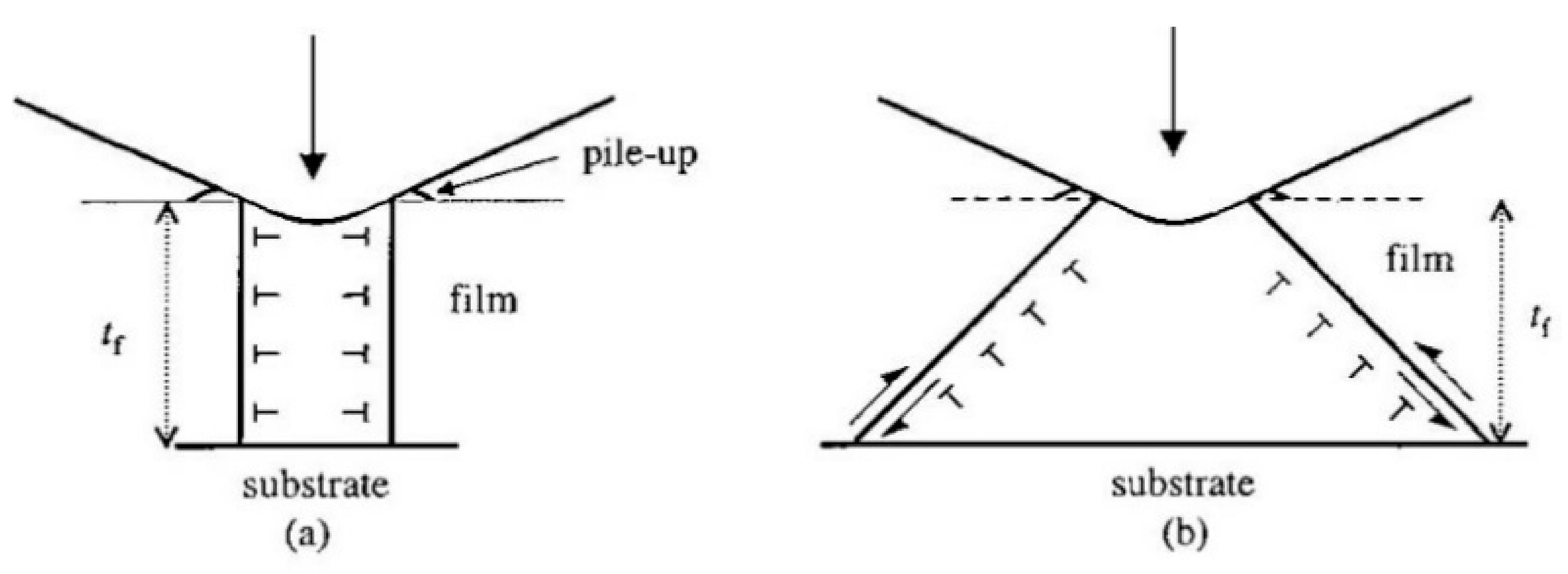


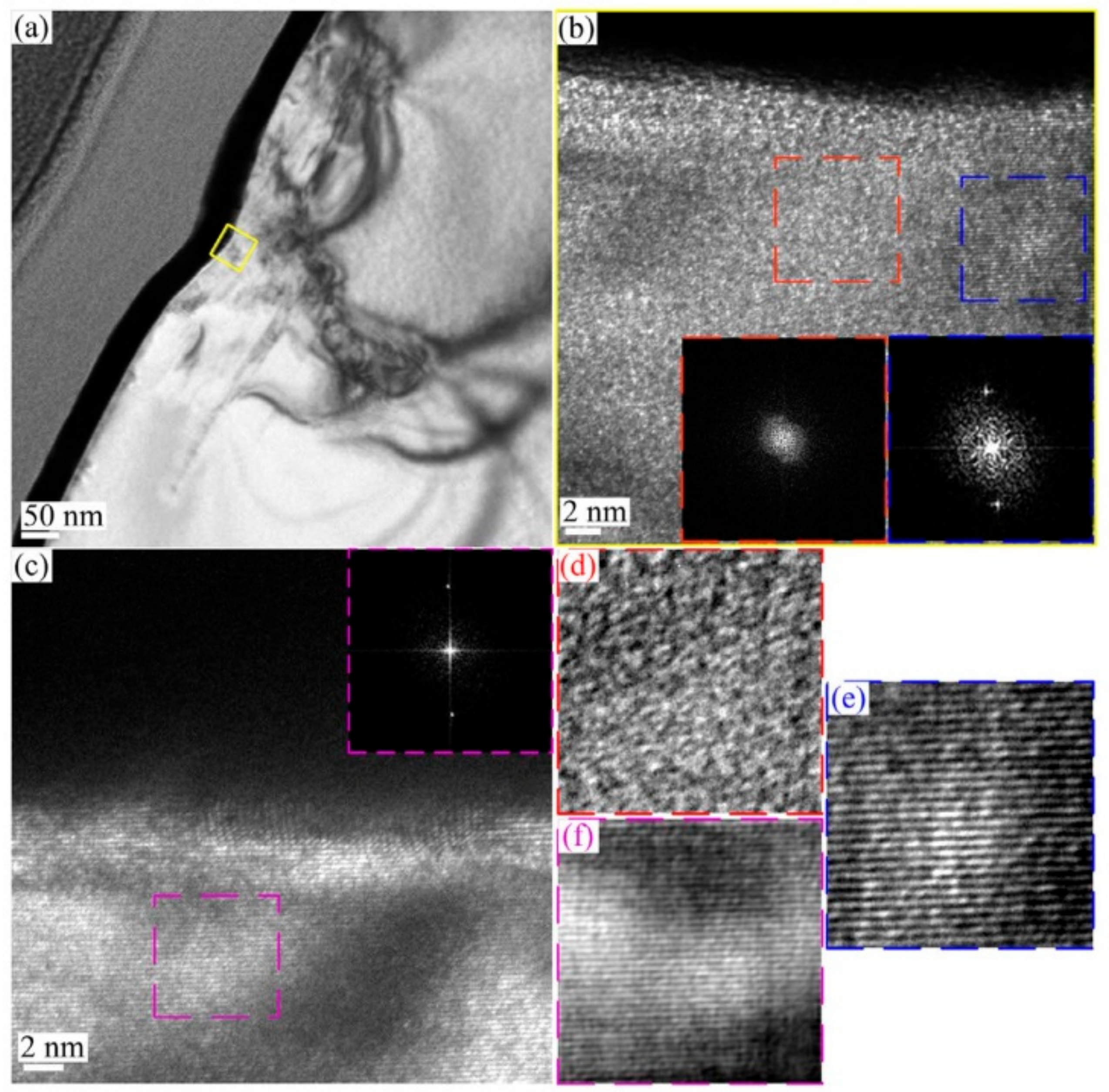
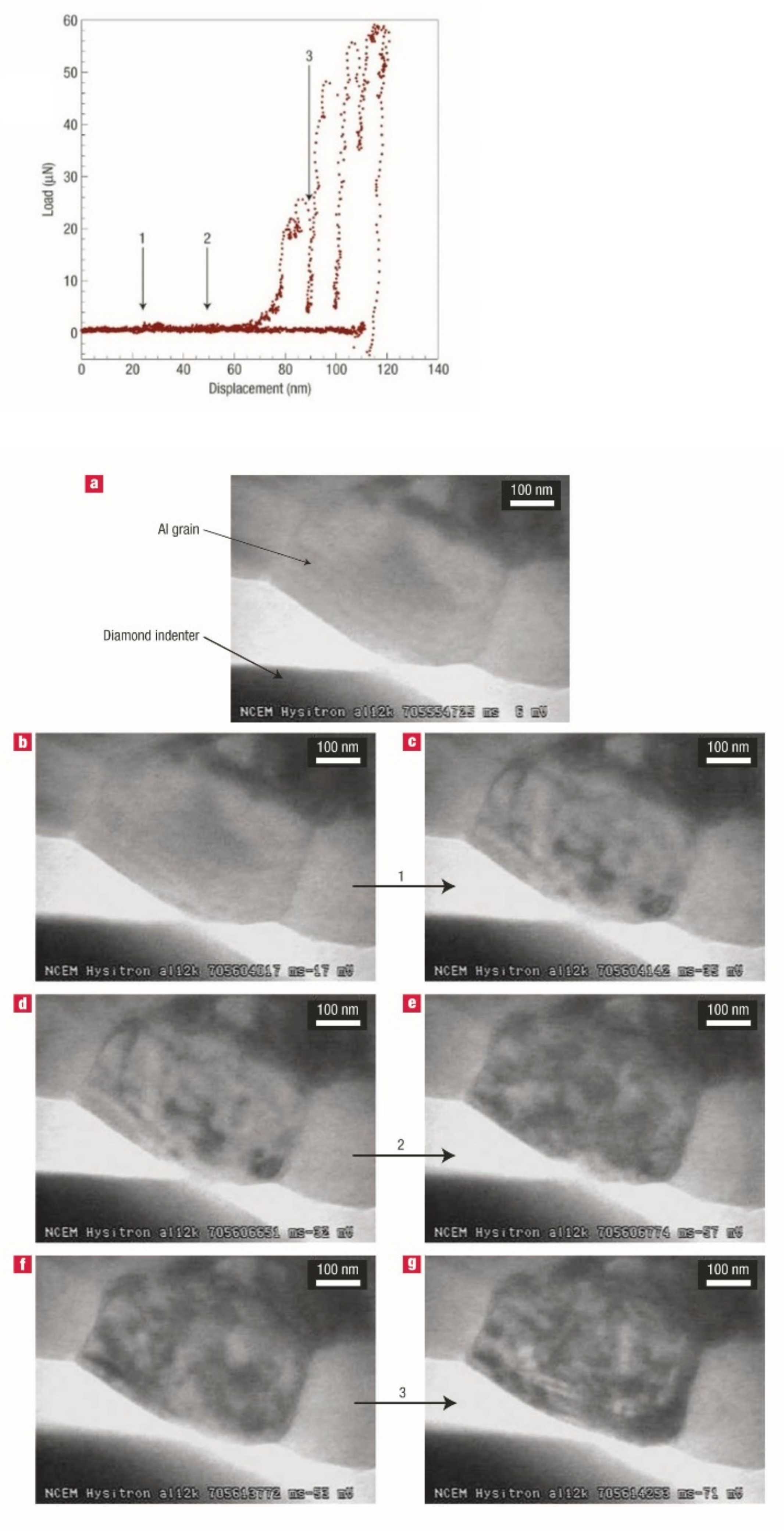
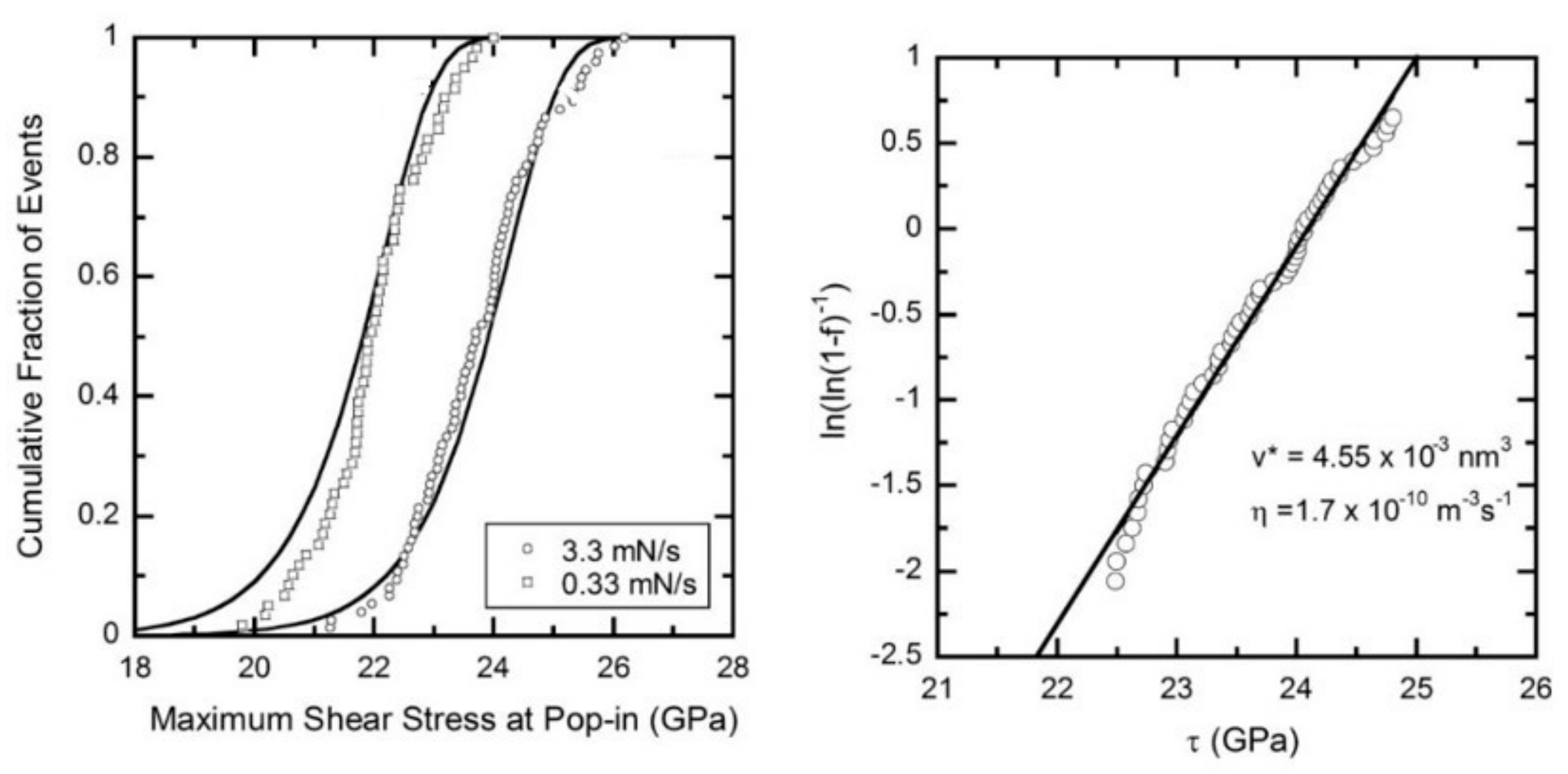
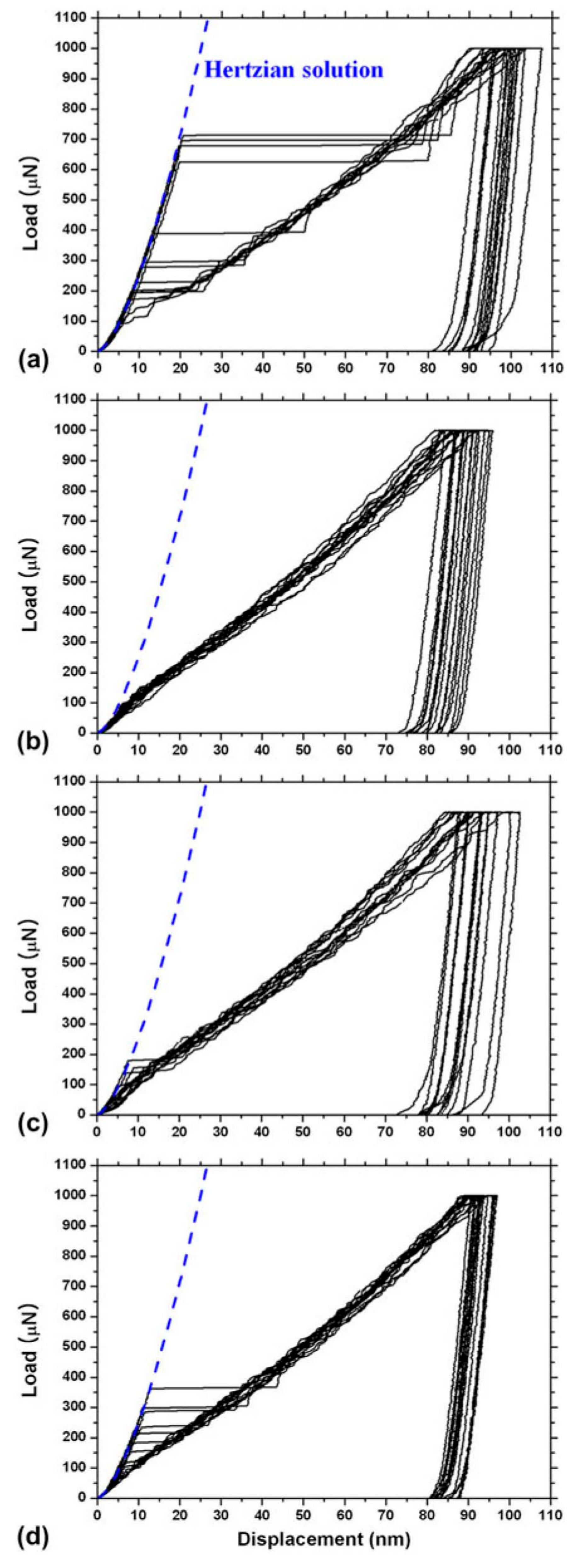
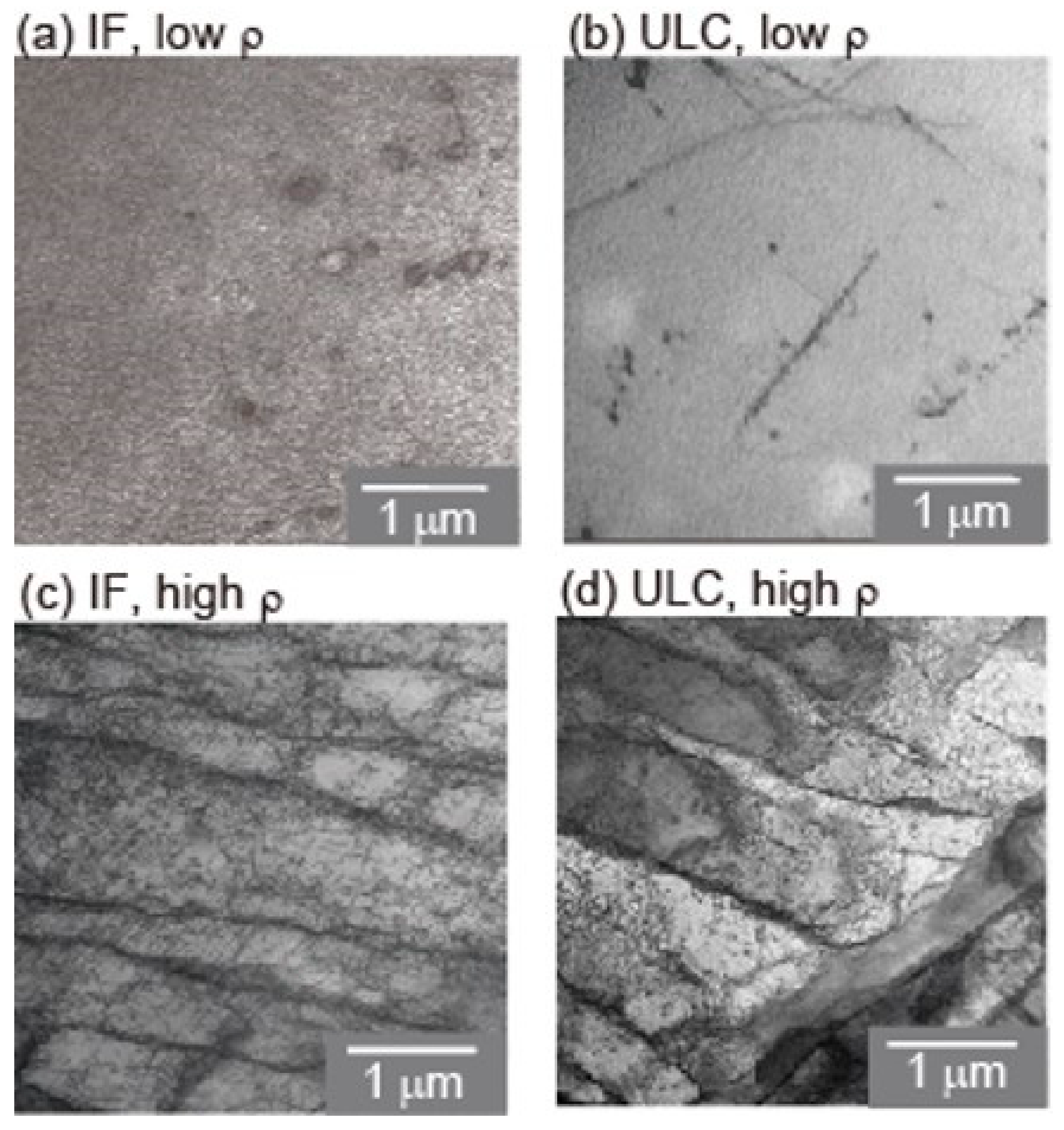

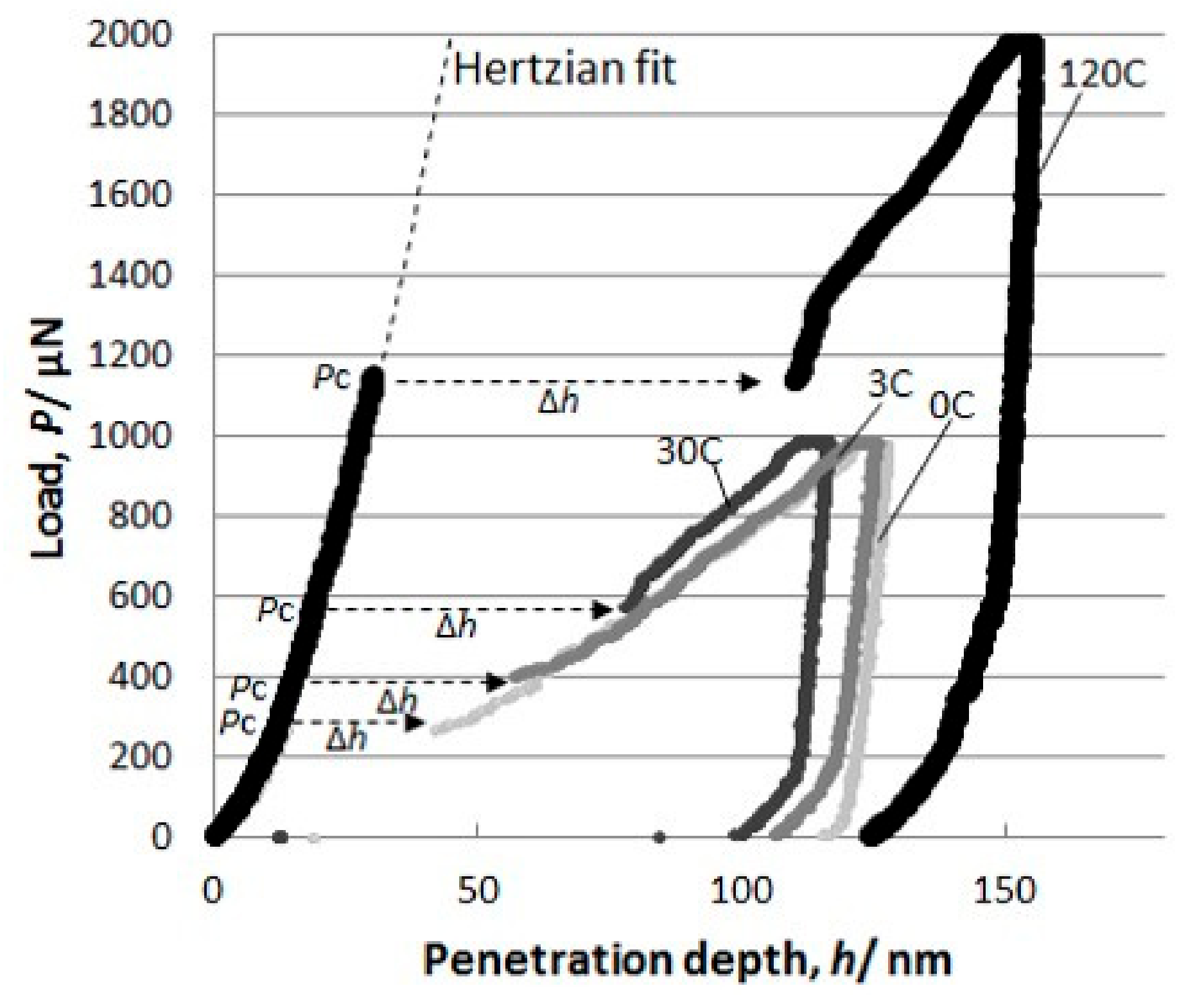


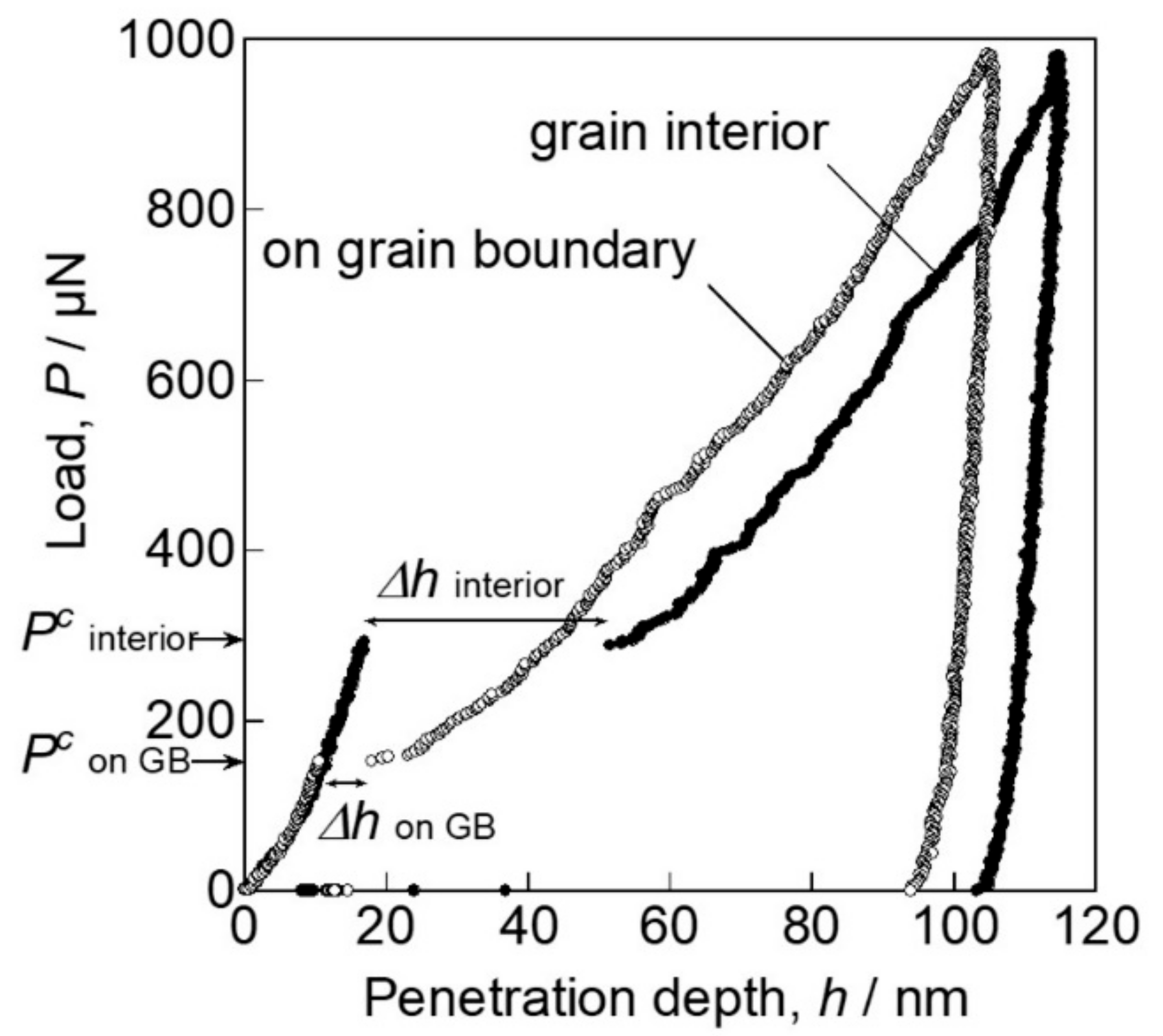

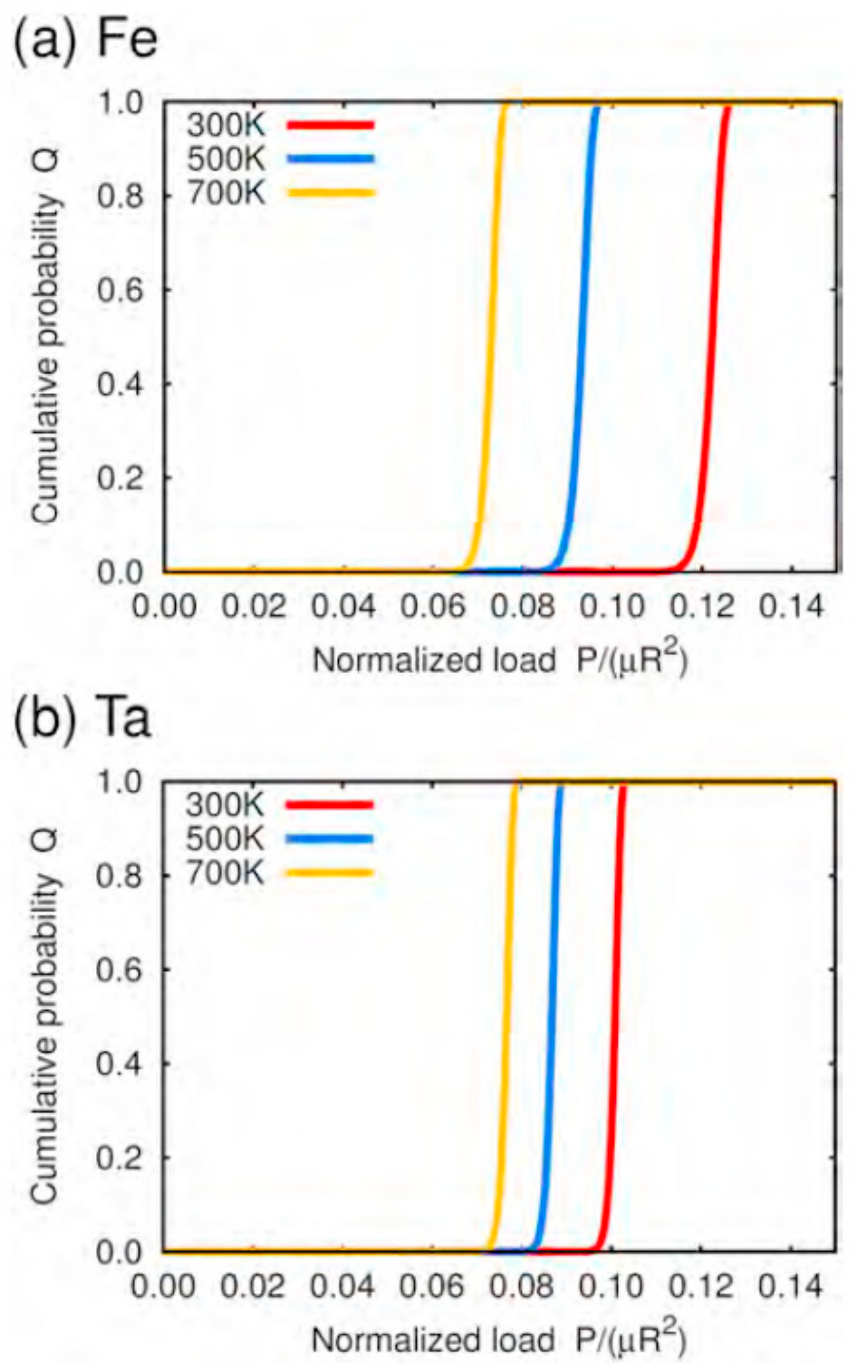
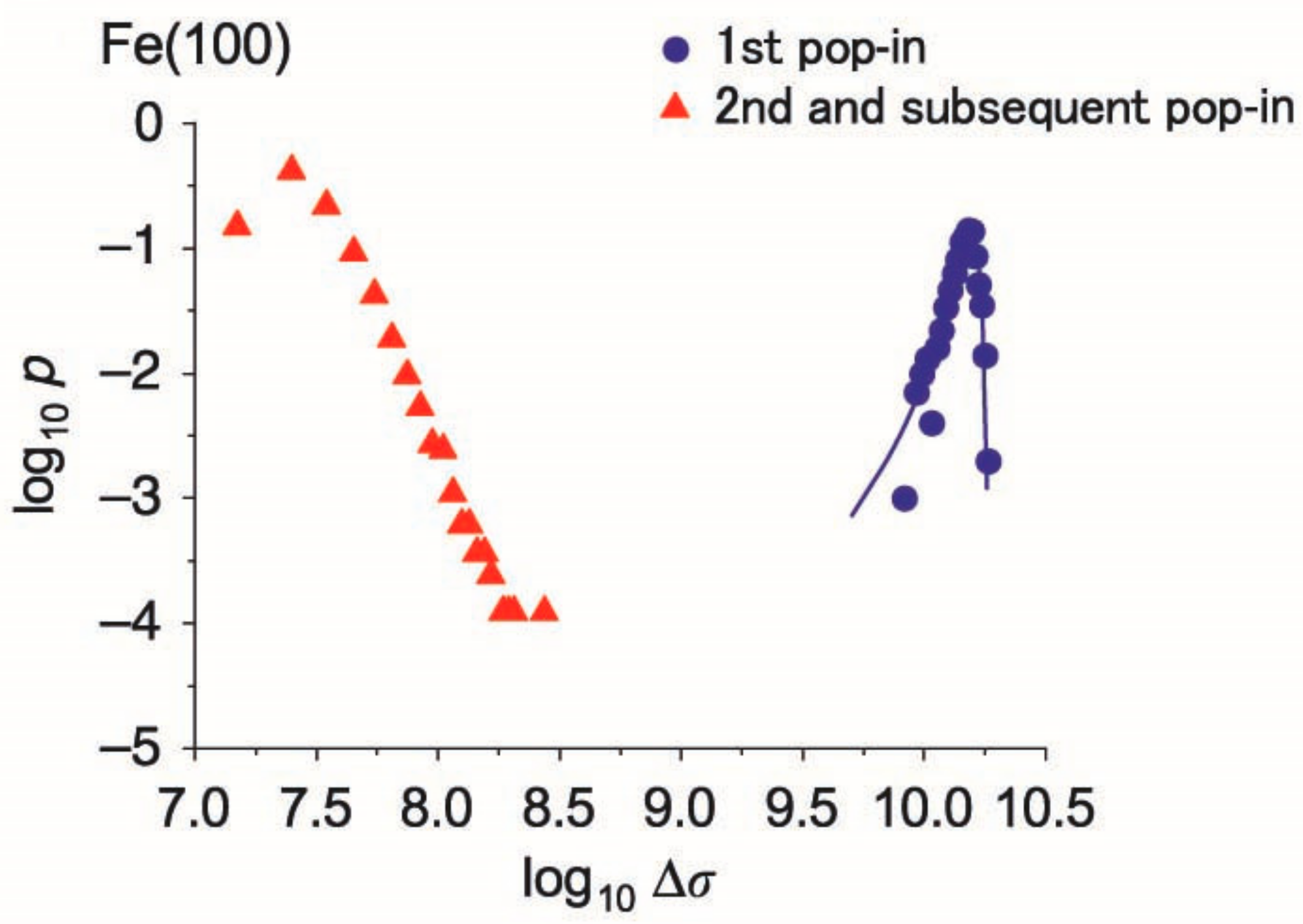
Publisher’s Note: MDPI stays neutral with regard to jurisdictional claims in published maps and institutional affiliations. |
© 2021 by the authors. Licensee MDPI, Basel, Switzerland. This article is an open access article distributed under the terms and conditions of the Creative Commons Attribution (CC BY) license (https://creativecommons.org/licenses/by/4.0/).
Share and Cite
Ohmura, T.; Wakeda, M. Pop-In Phenomenon as a Fundamental Plasticity Probed by Nanoindentation Technique. Materials 2021, 14, 1879. https://doi.org/10.3390/ma14081879
Ohmura T, Wakeda M. Pop-In Phenomenon as a Fundamental Plasticity Probed by Nanoindentation Technique. Materials. 2021; 14(8):1879. https://doi.org/10.3390/ma14081879
Chicago/Turabian StyleOhmura, Takahito, and Masato Wakeda. 2021. "Pop-In Phenomenon as a Fundamental Plasticity Probed by Nanoindentation Technique" Materials 14, no. 8: 1879. https://doi.org/10.3390/ma14081879
APA StyleOhmura, T., & Wakeda, M. (2021). Pop-In Phenomenon as a Fundamental Plasticity Probed by Nanoindentation Technique. Materials, 14(8), 1879. https://doi.org/10.3390/ma14081879




